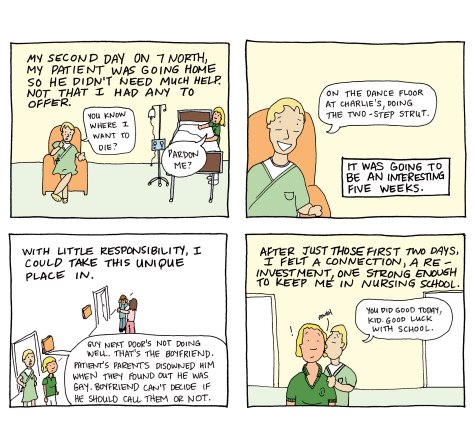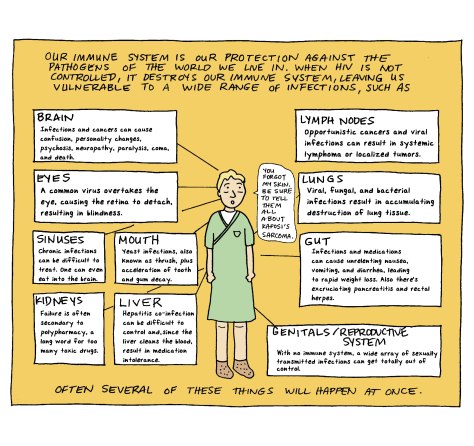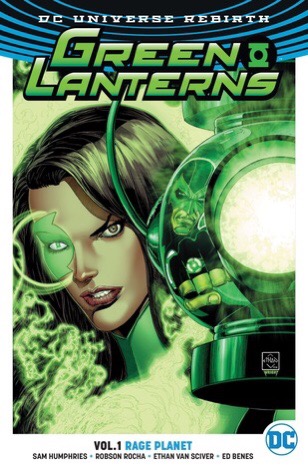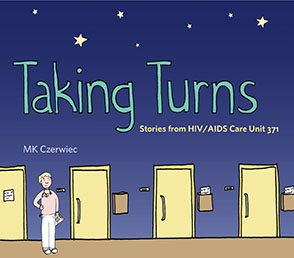A review of M.K. Czerwiec’s Taking Turns: Stories from HIV/AIDS Care Unit 371 (Graphic Medicine, 2017)
By Derek Newman-Stille

A graphic novel about a nurse’s experiences in an HIV/AIDS unit during the peak of the infection and when the infection didn’t have treatments that prolonged life as they do today seems as though it would be a depressing tale, and indeed it was. But, this was not just a tale of lives lost and the pain of losing friends and family, this tale was one of mutual support and community.
The history of AIDS is one that is enwrapped in Queer history, and like many parts of our history, it is erased. Unlike many other cultures, Queer culture isn’t passed down through family lines from one generation to the next. We often rely on members of our community to share the Queer history that they have uncovered.

M.K. Czerwiec helps to bring the history of the Queer community’s interactions with AIDS to new generations, letting us connect to aspects of our history not through the distant medium of history books that often bleed all of the emotion out of a historical event, but rather through her own personal experience with AIDS as a nurse who worked with people who were infected. In “Taking Turns”, Czerwiec shares her own story and how it touched multiple parts of the Queer community and the medical community as they engaged in a shared experience of AIDS. This is not a distant, pathological story, but instead one that is intensely personal, real, and relatable.
The medium of comics is one that was intensely powerful for the story of a nurse in an AIDS care unit because it prevented the sort of cool standoffishness that often occurs when we talk about AIDS, a distancing technique that we frequently use to pull ourselves away from the memory of those lost to the virus. But, with a comic, the reader looks directly into the eyes of the patients. We see their transformations as the virus progresses. We see the medical equipment that surrounds them and shapes their existence.

“Taking Turns” is an embodied experience where the story can’t be distanced from the bodies of the people involved. They are always present in the reader’s vision, preventing any pathologized readings or distancing. M.K. Czerwiec invites her readers into her world and her own history, making sure that we understand AIDS beyond the medical models we often receive.
When I was growing up, those of us in the gay community received constant warnings about AIDS. AIDS was constructed as the boogeyman haunting every sexual encounter. Posters were everywhere at gay clubs and in health units, warning us that we were one thin piece of latex away from certain death. These posters generally featured images of condoms or drops of blood or needles, but rarely let us see the human faces behind AIDS, the people who experienced the virus. This contributed to a lot of the fear around AIDS and the fear directed toward people with the virus. Czerwiec’ comic is one that I would have liked to have read as a young Queer person. It would have helped to humanize the people who had AIDS in our community instead of distancing us from them. It would have been a reminder that we, as a Queer community, need to pull together and protect and support our community.

“Taking Turns” is a painful narrative, but, more than that, it is a hopeful one – a tale of community coming together in a culture of care. It is a body story, one that is fundamentally about embodiment and the experience of living. So many AIDS narratives are about death and this one is also about life.
You can discover more about Taking Turns from Graphic Medicine at http://www.graphicmedicine.org
You can explore Taking Turns further at http://www.psupress.org/books/titles/978-0-271-07818-2.html













